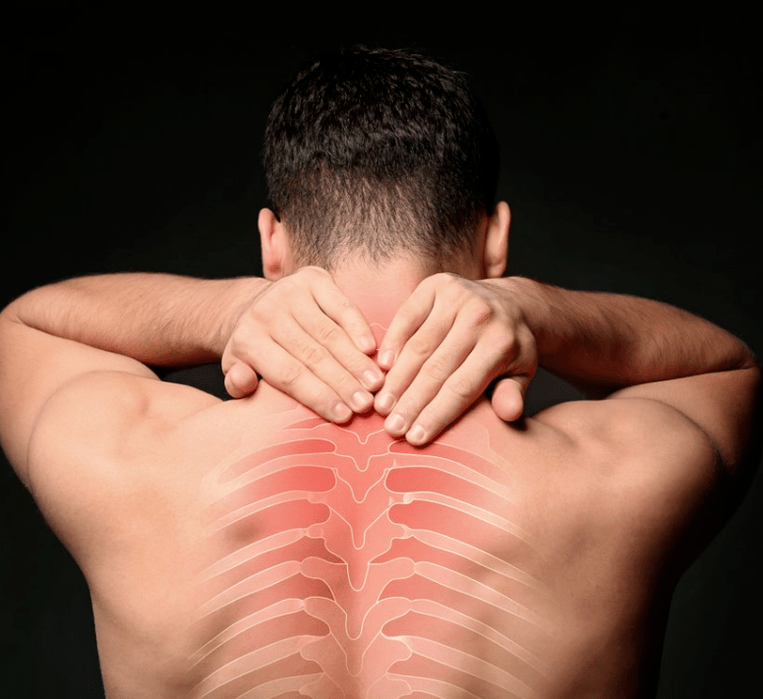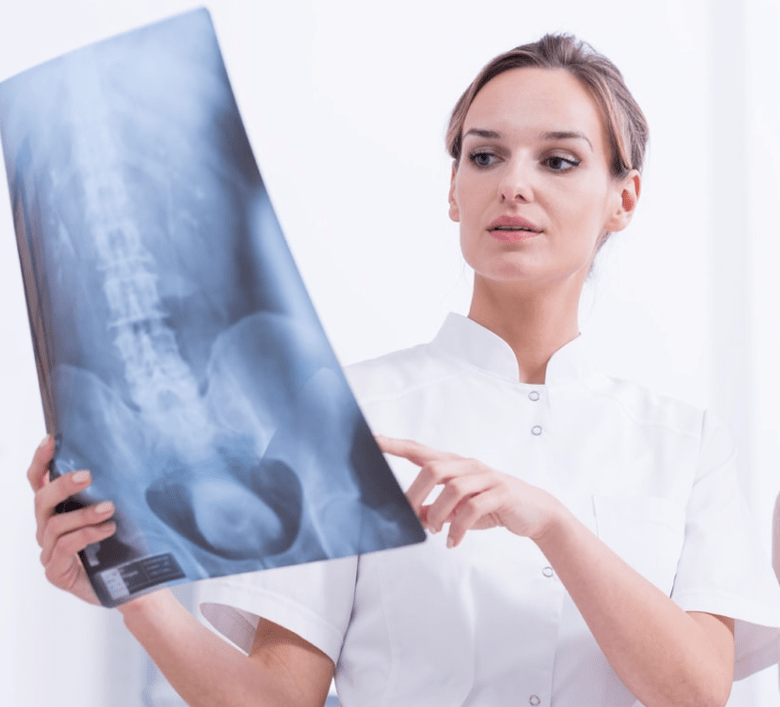
Osteochondrosis is the most common disease of all spine. Since osteochondrosis is a dystrophic-degenerative lesion of the discs located directly between the vertebrae, then, as a result, it causes an irreversible change in their structure, as well as the shape of the discs themselves, which form the thoracic spine.
As a person ages, these changes develop more and more in his back, and by the age of about 40-45, almost everyone experiences osteochondrosis of the spine. By themselves, osteochondrosis of the thoracic spine develops much less frequently than, for example, the lumbar or cervical spine, because the vertebrae in it are much less mobile than in other areas of the spine. In addition, the spinal area of the chest has a more developed muscle corset that supports the spine in the chest area much better than the others.
What is this osteochondrosis of the chest?
Chest osteochondrosisDirectly represents the stratification of the discs between the vertebrae by a simultaneous reduction of their thickness and, consequently, by the further suppression of the nerve endings located in the intercostal zone of the human breast.
However, we note once again that because physiological fixation by the ribs in humans is quite rigid, the spine in the chest area is the least susceptible to osteochondrosis. This is osteochondrosis of the chest, which is a rare occurrence, for example, osteochondrosis of the cervix or lumbar spine.
Usually with osteochondrosis of the thoracic spine, the process of pathology involves discs between the thoracic vertebrae that cover the twelve thoracic spine. But most often with osteochondrosis of the chest region, pathological changes occur in the upper chest vertebrae. There are several degrees of lesion with osteochondrosis of the chest and we will discuss them in more detail later.
Determinants of the development of thoracic osteochondrosis
The exact causes of osteochondrosis of the chest region have not yet been fully established by modern science. At this time, it is common in medicine to distinguish the following predisposing factors, or so-called risk factors, that cause osteochondrosis of the chest region in the spine:
- Hereditary predisposition;
- Excessive physical activity in this section of the spine;
- Spinal injuries such as falls or bruises on the chest;
- Changes that occur with age in the intervertebral discs and lead to a decrease in hydration in the disc tissues;
- Disorder of blood supply to the chest.
Contributing causes of osteochondrosis disease of the chest
The development of osteochondrosis is mainly facilitated by hypodynamics, ie lack of muscle load, which leads to a weakening of the functions of the muscular corset and, consequently, an increase in loads on the intervertebral discs and ligaments.
Additional reasons for the development of chest osteochondrosis are:
- Body hypothermia;
- Existence of chronic stressful situations;
- Transmitted infections;
- Hard working conditions;
- Hormonal disorders in the body;
- Disruption of the metabolic process in the body;
- The presence of congenital defects of the spine, in particular, its chest region.
Under the influence of a combination of these factors, or sometimes on one, irreversible dystrophic-degenerative processes develop over time in the discs between vertebrates:
- The intervertebral disc nucleus gradually begins to lose fluid, which is released by them to provide lubricating function, which ultimately significantly reduces the damping function of this disc;
- The fibrous ring of the spine itself, due to the increased load on it, becomes more vulnerable, which in turn leads to its gradual destruction.
Symptoms and signs of chest osteochondrosis
The clinical symptoms of thoracic osteochondrosis depend entirely on the following factors:
- Patient age;
- Degree of susceptibility to disease;
- Stages of thoracic spine osteochondrosis: remission or exacerbation.
The main signs of chest osteochondrosis are:
- Pain in the chest, so-called Dorsago;
- Painful damage to the nerve endings of the spinal cord - radiculopathy;
- Abdominal syndrome;
- Heart syndrome or changes in the heart muscle, with characteristic pain that persists even when exposed to trinitroglycerin;
- Pulmonary syndrome, in the form of stagnation in the lungs with signs of hypoxia, or suffocation.
No increase in body temperature is observed in a patient with thoracic osteochondrosis, which is also a direct differential diagnostic sign. Dorsalgia in the chest, as one of the main symptoms of osteochondrosis, indicates the appearance of cracks in the flat anbus fibrosis and deformation of the nuclear pulp. On palpation the pain in this area of the chest only intensifies, the symptoms increase.
In addition, the typical symptoms of thoracic osteochondrosis with compression myelopathy, or deformity of the nerve endings, are:
- Feeling of "goose bumps" - paresthesia;
- Pain along the compressed nerve - are common symptoms;
- Decreased and sensitive to temperature sensitivity;
- Impaired spinal motor function is also one of the characteristic symptoms.
After detecting such symptoms you should see a specialist. The appearance of symptoms in the complex and their intensity are especially dangerous. At the same time, it is inappropriate to treat the symptoms without eliminating the causes and factors of the disease.
Degrees of the disease with thoracic osteochondrosis
Each degree of disease with osteochondrosis of the chest is characterized by its own pathology, which has only its own clinical signs. Modern medicine distinguishes between four degrees of degenerative disc disease of the chest region (similarly - degenerative disc disease of the lumbar and cervix) and, consequently, four periods of its development. Let us consider them in more detail.
ᲞNir quality,Which is characterized by cracks appearing inside the fibrous ring into which the nucleus subsequently reaches the pulposus. This period of development of osteochondrosis of the chest is characterized by the following symptoms:
- The appearance of pain in the back that does not go beyond the localization of the lesion;
- These pains may be persistent or expressed by lumbago;
- There may be a convulsive contraction of the muscles in the chest area accompanied by pain in the heart area.
Second degreeThe development of thoracic osteochondrosis is characterized by increased pathological production of interstitial movement with the following clinical manifestations:
- subluxations appear in the thoracic spine;
- Pain increases during movement;
- Discomfort occurs with prolonged posture.
Third degreeCharacterized by rupture of the annulus fibrosus and protrusion of the nucleus pulposus beyond it. During this period, osteochondrosis of the thoracic spine begins with an intervertebral hernia, the clinical signs of which are quite severe. Namely-neurovascular, muscle tonic, and reflex-dystrophic.
In addition to the above, the third degree of osteochondrosis of the chest region is characterized by a change in the following conditions of the spine:
- Weak fixation of the spine position;
- Restriction of mobility of the spinal region, manifested in the form of kyphosis or scoliosis.
Fourth degree- The dystrophic-degenerative process already affects all the structures surrounded by the spine. This pathological process involves the yellow, medial, and other ligaments, and fibrosis occurs in the structures surrounding the spinal column. In this period of the disease with osteochondrosis of the chest, a state of so-called remission is clinically observed.
Complications
With further progression of the disease with thoracic osteochondrosis it is possible to develop the following complications:
- Inflammation of the nerve endings of the spinal cord;
- Emergence of intervertebral hernia;
- Development of vascular dystonia;
- Schmorl hernia development;
- Spondyloarthritis;
- Abnormal growth of bone growth - osteophytes;
- Significant reduction of the spinal canal.
It should be noted that the severity of complications arising during thoracic osteochondrosis depends entirely on the progression of the resulting disease process and, of course, on the effectiveness of treatment methods for thoracic spine osteochondrosis.
Diagnosis and its methods

In practice, several methods are used to diagnose osteochondrosis of the chest. The most common of these is radiological examination, the results of which are quite informative. The signs of chest osteochondrosis identified in this study are as follows:
- The contours of the discs between the vertebrae are broken;
- The edges of the integrated plates acquired a wavy character;
- The intervertebral discs have changed shape;
- Osteophytes appeared - abnormal bone growths of the spine;
- Increased and tightened vertebral nut-shaped processes;
- The bodies of the thoracic spine have changed to a normal shape;
- The height of the discs between the vertebrae was significantly reduced;
- Herniated discs arise between vertebrates.
In some cases, the method of diagnosing osteochondrosis of the spine is used by contrast X-ray examination, which identifies the following signs of this disease:
- In the case of advanced pathology, a contrast agent fills the disc between the vertebrae;
- With the help of a contrast agent the contours of the nucleus pulposus are seen, which are unequal;
- When the intervertebral disc is destroyed, the contrast agent largely extends beyond its boundaries before penetrating the spinal canal.
Only a correct diagnosis can determine the right treatment.
Treatment of osteochondrosis
Chest osteochondrosis can be treated in one of the following ways, based on the diagnostic results of chest osteochondrosis, namely:
- Conservative-traditional treatment of the spine;
- Treatment of thoracic osteochondrosis with traction;
- Operative surgical intervention.
Treatment of thoracic osteochondrosis, called conservative, is difficult to treat with any type of osteochondrosis: medications, physiotherapy, physiotherapy exercises. Nonsteroidal anti-inflammatory drugs (NSAIDs) are intended to relieve back pain known as thoracic osteochondrosis. It should be noted that these medications very well eliminate inflammatory processes, as well as the resulting swelling, which helps to reduce the compression of the nerve roots. In more severe cases of breast osteochondrosis, the attending physician may prescribe a number of additional medications, such as some strong painkillers and muscle relaxants that block the onset of muscle spasms.
When the pain subsides or is stopped, ie during remission, physiotherapy treatment is prescribed, as well as additional exercise therapy and massage. These are all important components of a comprehensive treatment. One of the main physiotherapeutic means for the treatment and prevention of the disease is pulsed magnetic therapy using special medical devices for clinical and home use.
In case of exacerbations only magnetotherapy of special parameters is allowed; There are medical devices for treating both acute and chronic pain. This system is also suitable for the treatment of lumbar and cervical spine.
In addition to the above, traction treatment, i. e. treatment of thoracic osteochondrosis with special traction, can be successfully used to treat thoracic osteochondrosis. With this method, the paravertebral muscles, tissues, and ligaments are stretched, leading to an increase in intervertebral distance. Even one and a half millimeters will already be enough to reduce swelling, eliminate compression, as well as relieve tension in the muscles surrounding the spine. In any case, the main principle of conservative treatment is its complexity. Treatment should be done for a long time and regularly, this is the only way to hope for results.
But surgical intervention, as a type of treatment for osteochondrosis, is advisable only when the above methods of treating osteochondrosis of the chest do not give the desired result.







































